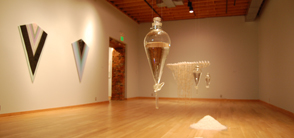Curator Caitlin Gill's Group Exhibition Brings Representation into the Post-COVID Era
February 21, 2024
Words: Quentin Gibeau
Recently I met someone with a chronic pain condition. It is unpredictable and can make every day a different kind of negotiation with the capabilities of their body. In art spaces, as well as in common life in the wake of the COVID-19 pandemic, there have been more discussions about access, chronic pain, and able bodied-ness in public space than before—an unexpected blessing of the pandemic for equity. I’m sure we’ve all been reminded of this in one way or another, with the most recent COVID spike over the holidays, as now suddenly more of the general population has faced a potential debilitating long term consequence of disease.
This underlying zeitgeist is perhaps unintentionally reflected in Maryland Art Place’s new show, Embodiment, on view through March 23. Utilizing the common element of corporal living as a jumping-off point to bring together a myriad of Baltimore region artists, the show presents a consistent strength (and perhaps burden) of MAP; an overwhelming breadth and volume of work that is able to fit into the space without feeling crowded, while utilizing placement and juxtaposition to create connections. This has especially become a hallmark of shows from Caitlin Gill, a curator who seems to be everywhere at once in a specific sector of the Baltimore art scene.
“The show wasn’t intended to be actively political, but the body is always political,” Gill explains. “Representation of the human body is political, and initially I wanted to focus on a show that would center the figure, which is always relevant, since we all have a body. The show inevitably morphed into an investigation into the rediscovery of figure and form, which to me felt like an answer to the cliche of ‘painting is dead’. People who dismiss figurative representation don’t have to think about their own representation in the world.”
Gill’s approach invites the viewer to make a lot of their own connections—bodily autonomy, dysphoria, transition, labor, and systemic racism are all present topics in this show. Unintentionally, the show also brings to mind our old friend social distancing, through proximity of the work and the corporal subtext.
Walking into the space, the viewer is greeted by several representational sculptures of the human form. The first, the goblin-like “Flaying Of Marcella” by Trisha Kyner, is very much ceramic but appears not to be. Next to the window, three headless resin sculptures from artist Lania D’Agostino almost convince the viewer into believing that they are ceramic. These cast human bodies, “Kristen to Kris in Three Stages”—with all of their hyper-detailed goose pimples, hair texture, and dimples—accomplish the task of alienating the viewer from the idea of a body, illuminating how truly strange we are, physically in this headless context, as well as documenting the slow process of gender transition. D’Agostino’s piece is a palette cleanser for some of the more nuanced work in the rest of the show.
In our post-COVID reality—wherein the virus hasn’t really gone away and “post” exists as a marker of its advent—one role of art is to reinforce a new consciousness about our bodies, for better or worse to create empathy in an age of hyper-individualization. Many of the artists in the show harness a unique sense of bodily consciousness, with Hoesy Corona’s exploration of the body in relation to concepts of the other, race, immigration, and gender being no exception.
Through the medium of garments both decorative and wearable, his long-running Climate Ponchos series makes evident the ways the human body is tied to labor, the environment, and displacement. The ponchos have gone through many evolutions, including various forms of transparency and as costuming for performance. These works, however, are opaque, transforming the poncho into a more traditional canvas.
Corona’s latest poncho iterations are fabricated with digital jacquard weaving, reminiscent of Akea Brione’s solo show at CPM Gallery in Bolton Hill last summer. But while Brione’s work in that show employed artificial intelligence to generate or manipulate imagery, a more direct play between the presence and absence of the human body was conceptually and logistically central to Corona’s practice.
“At the onset of the pandemic I had to pivot the way I made art since I had limited access to my studio,” Corona recalls. “I couldn’t work with performers, so I hired a single performer and outfitted them in bodysuits (harking back to the original Climate Poncho silhouettes) and started doing what I see as ‘performances for the camera’.” The resulting imagery was then digitally collaged, transferred to fabric, and hand-embellished with embroidery.
Close to Corona’s work one encounters Marie Amegah’s prismatic, mixed-media paintings of the human form. They are almost conspicuously out of place aesthetically among the rest of the show—reminiscent of quilting, jewelry, and a somewhat late 90’s academia design aesthetic—channeling bookstore-lurking elders, who might inhabit such an aesthetic.
Catty-corner to Hoeseys work is the sculptural work of Michelle Dickson, who utilizes driftwood and resin to create life like collage sculptures, embedded with organic found objects. These feel like pieces of preserved floral mummies, similar to the titular Green Knight of David Lowry’s film, as well as the post civilization monstrosities of Alex Garland’s Annihilation and the myriad of fungus strigoi from The Last Of Us. In an exhibition of very strong visual work, these pieces are jarring in their unexpected realism and utilization of a natural aesthetic steeped in decay and psychedelia that would make Ian McHarg and Lee Bontecou proud.
Dickson’s work pairs well with Trishia Kyner’s petulant living room creatures. Presented in the center of the space, they feel delightfully absurd. “Prudence in the Knacker’s Wagon” rests on a wooden wagon that you’d drag a toddler around in, or the town drunk. The figure seems to be on its side and the viewer can imagine it either hungover or throwing a fit. This grotesque and cute humorous beat is repeated with another funny little guy just hanging upside down from what resembles a gymnastic bar. These two sculptures evoke traditional gargoyles who’ve had their growth mysteriously stunted, and through the softness of their rendering also recall the snuggliness of Pokemon. Kyner’s aesthetic sensibilities are strong, and the space could easily be dominated by more of their work.
Kyner’s work isn’t alone in its totems of the Id, however. Allen Linder’s sculptures—reminiscent of soap stone and caribou carving of indigenous Alaskans, as well as the smooth cartoony work of Italian futurists—brings it home with the addition of googly eyes. There is a dysmorphic element to Kyner and Linder’s work, like a soul trapped in the horrors of an absurdist form. Kafka meets the Animaniacs.
Surrounding these absurdist altar pieces in the main interior of the MAP exhibition space, the viewer is flanked by repetition in the respective works of Scott Ponemone and Richard Lopez Hernandez, who goes by RLo. Ponemone’s untitled works are straight-ahead illustrations attempting—perhaps unintentionally—to create a sobering political cartoon, bookending the exhibition space. In one series of paintings, Ponomone uses the allegory of bullet-riddled targets held up by the hands of Black and white people with the subjects remaining out of frame.
Earlier in the exhibition, Ponomone has a corresponding set of paintings, featuring beautifully rendered infants. The babies are echoed in these target paintings, with their skin tones corresponding to the hands in the other series. In a commentary on institutionalized racism, state violence, and fear mongering, Ponemore’s paintings would serve as a worthy litmus test in provoking a discussion about said topics with the viewer. However, in the context of some of the interior focus of the show’s other work, the message feels somewhat abrupt. And while still being in line with the theme, their placement in the show almost does this particular work a disservice.
RLo Hernandez’ two large scale drawings are rendered in charcoal with a blended middle ground, creating a sort of ether for various elements of the compositions to float in and out of. In RLo’s larger untitled drawing on the east side of the gallery, this monochromatic middle space creates a fog of war, with overlapping human figures seemingly fleeing something unseen, one carrying an infant. Hernandez’s other untitled work is inside the small cubicle on the west side of the gallery, and replicates the “ether” effect on a more individual level, utilizing the middle ground to show many figural and corporal elements seemingly flashing in and out of existence in a blur, much like trying to read text in a dream.
Herandez’s work evokes Picasso’s “Guernica,” Fritz Lang’s Metropolis, and Stephen Gammell’s illustrations for Scary Stories To Tell In The Dark. These two works are simmering with horror, disillusionment, and a structural ambiguity that feels eerily prescient of our current moment, politically and globally. Without much effort, the inescapable casual viewing of the bombardment of Gaza has given even the most politically disconnected person a first hand account of the kind of horror of the atrocity that inspired Picasso’s famous work. To have this horror reflected back intentionally or unintentionally by Hernandez, one can feel the emotional evisceration of the deconstruction of corporal thought, whether it is loss of one’s body, culture, or state.
The way we all inhabit our bodies surely must feel different. That’s part of some of the universal subjectivity of existence, and a baseline intro to the Richard-Linklater-level existentialism present in our TikTok reductionist age of being “the main character,” to borrow an internet idiom.
Art as an extension of the body—and, by proxy, the humanities in general—does a lot of heavy lifting in the effort to build empathy in our common populace. Thich Nahn Tahn talks about the limerance of passing someone on the street and realizing there are buddhas in all of us, everyone living their own lives with their own struggles, each with their own suffering. This is refreshingly evident in the breadth of work on display in Embodiment, and through the collective efforts of these artists, it’s hard to forget how important it is to walk in someone else’s shoes.
‘Embodiment’ is on view through March 23rd, and features of the work of Marie Amegah, Evan Boggess, Hoesy Corona, Joan Cox, Lania D’Agostino, Michelle Dickson, Christin Fanelli, Richard Lopez-Hernandez, Trisha Kyner, Allen Linder, Kate Norris, and Scott Ponemone.
The show is curated by Caitlin Gill.
Click here for the full article.


.jpg)
.png)
.png)
